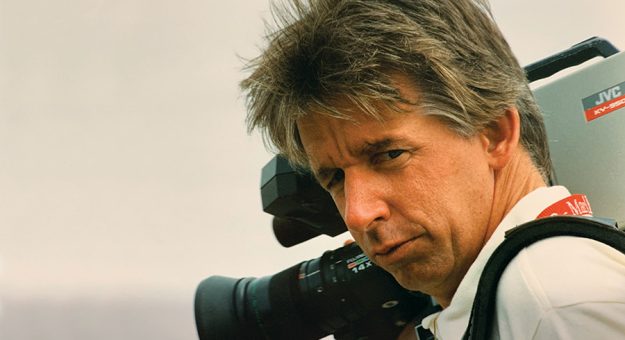Thirty-five years ago, a tall guy with a shock of dark hair showed up at Anderson (Ind.) Speedway with a camera on his shoulder.
Things worked out exactly as they were supposed to.
Thirty-five years ago, a tall guy with a shock of dark hair showed up at Anderson (Ind.) Speedway with a camera on his shoulder and a tape deck hanging from a strap. Greg Stephens was eager and enthusiastic, and he had a plan.
A highly unlikely plan, but it was a plan.
It was May 1986, and Stephens had written for a media credential to cover the Little 500. I was the part-time PR man for Anderson Speedway at the time, and when he arrived at the track on Friday morning Stephens sought me out to talk about the layout and scope out the best vantage point to film the race.

He explained that he was from the St. Louis area and had recently quit his job to hit the road, intent on following sprint cars and other short track races. He proudly showed me his video equipment and explained his plan.
He would travel all over the country and film races, making a living by selling footage to various motorsports shows as well as selling VHS tapes to racing fans. I nodded politely. In truth, I figured this dreamer was on the fast track to starvation.
The fact is, Stephens was a pioneer. And pioneers always face skepticism and uncertainty.
Stephens is dealing with some health challenges today, and his path is difficult. As he fights the good fight, it has prompted a great many memories of our friendship through the years.
Our paths crossed countless times since that first meeting in 1986, each of us working at tracks across the nation. We‘ve often laughed about that first meeting, and the amazement that Stephens somehow made his plan work — for more than 30 years.
The value of his work was immediately obvious in 1986. A few days after the Little 500, a VHS tape landed in my mailbox. Greg had filmed the entire race, narrated a voice track, and included victory interviews at the end.
It was, in a word, fabulous.
At the time, this was an amazing development. The ability to see a first-class video presentation of a short track race within days of the event was a genuine breakthrough. His camera work was excellent, and the footage could live on for generations.
As he began to travel throughout the country, picking and choosing various short track events to cover, Greg quickly became the go-to guy when it came to getting racing highlights on television. Cable television was still very much in a young and rocky development period, and several weekly motorsports-themed news and highlights shows had begun to appear on various networks, including ESPN‘s Speedweek.
But the process was not simple. The technology of the day was analog—not digital. This meant that the physical media — videotape — had to be duplicated, then edited through a cumbersome process. Once a highlight package was complete, it had to be duplicated onto another tape and shipped to the network studio via express delivery — typically Federal Express, now known as FedEx.

There were other challenges. Because he worked alone, Stephens had to handle post-race interviews himself. When possible, he‘d recruit a media friend to hold the microphone and ask questions of the subject. If nobody was available, Greg would perch the camera on his shoulder and extend the microphone toward the subject with his left arm.
It looked awkward, and it was. But with practice, he learned to maintain a steady image while the recorder was rolling.
In 1987 Stephens acquired a Ford van and outfitted the back like a miniature production studio. By assembling the needed equipment — tape decks, audio deck, microphone, etc. — he could hurry back to his van after the races and begin the tedious task of narrowing several hours of video down to a one- or two-minute highlight package, usually cutting several copies. Then he would fire up the van and rush to the nearest airport, where he could overnight the tapes to the various networks.
This was also the year that saw Stephens alter his plan slightly. Instead of covering a broad array of races, he would focus on one series. After convincing Ted Johnson of the value of having World of Outlaws highlights consistently appearing on national motorsports shows, Johnson agreed to pay Stephens tow money to travel to all of the Outlaws races and produce highlights for the networks.
For the next 17 years, Stephens and that familiar gray van wore out America‘s highways.
The impact of his effort was both immediate and enduring. For the first time, millions of viewers throughout the nation — and much of the world — could visually follow the grueling schedule of the Outlaws. In addition to reading about Steve Kinser, Sammy Swindell, Doug Wolfgang, Ron Shuman, Bobby Davis Jr., Dave Blaney, et al, in magazines and racing newspapers, now they could hear their voices. Now they could get to know them — even better.
Stephens built a contact list of virtually every motorsports TV production company in America, and a great many sports directors at various networks and TV stations. That made him a crucial resource just as television was taking baby steps toward covering sprint car racing.
There were racing people, and there were television people. Neither group knew the other.
But Stephens knew both sides. And, with the same persistence that led him to take on this nomadic, breakthrough lifestyle, he pestered studio people to consider showing sprint cars on TV.
Click below to keep reading.
